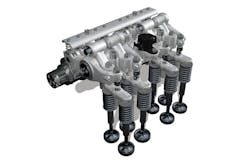Jacobs Vehicle Systems, best known for its “Jake” engine compression brake, is prepping a demonstration truck that will travel the United States this year to allow customers to experience new technologies that can meet tougher emissions regulations while increasing fuel economy.
Robb Janak, Jacobs’ director of new technology, said the 58-year-old company has spent much of this decade “repositioning” itself to provide a greater range of transportation solutions.
This comes as the company begins rolling out the updated High Power Density engine brake that can offer drivers twice the braking power as the current brake, and provide improved braking capabilities at a lower rpm range.
Besides the brake, the demo truck will also feature Active Decompression technology to aid in start-stop applications. The technology is designed to reduce vibrations when the engine is turned off during traffic congestion and in frequent idle situations.
It is automatically activated by the engine control unit whenever the engine shuts down or starts up, and works by keeping the engine valves open and the cylinders decompressed. Jacobs said the system also improves start-ups in cold temperatures by enabling the engine to reach its critical compression ignition speeds.
Another technology being development but not planned for this year's demo truck is the cylinder deactivation (CDA) system, which cuts emissions by achieving higher exhaust temperatures in the operating cylinders.
As a result, large engines are able to have the fuel economy of smaller engines. At the lowest engine loads and with three of six cylinders deactivated, fuel consumption improves by up to 20%.
Janak said CDA development is particularly important, because it can offer both lower emissions and higher fuel economy, which were earlier considered to be mutually exclusive.
Jacobs is also introducing a two-step variable valve actuation system designed to enhance performance across an engine’s operating range.
In a separate announcement earlier in May, Jacobs announced its engine brake model 5783A is now standard equipment on the International A26 engine.
Jacobs has supplied a compression release engine brake for International Truck’s 13-liter engine since 2009. The 5783A model comes factory installed on International LT series, International RH series regional haul vehicles, and International HV and HX series vehicles.
“We are excited to be a standard feature on the International A26 engine, complementing their technologies for the on-highway, severe duty, and vocational segments,” Steve Ernest, vice president of engineering and business development for Jacobs, said in a statement.
Also in May, Jacobs was selected as a recipient of the John Deere Innovation Award for 2018. The award is presented to suppliers who have demonstrated innovation in a product or service they provide to John Deere.
About the Author
Neil Abt
Neil Abt is a former FleetOwner editor who wrote for the publication from 2017 to 2020. He was editorial director from 2018 to 2020.
